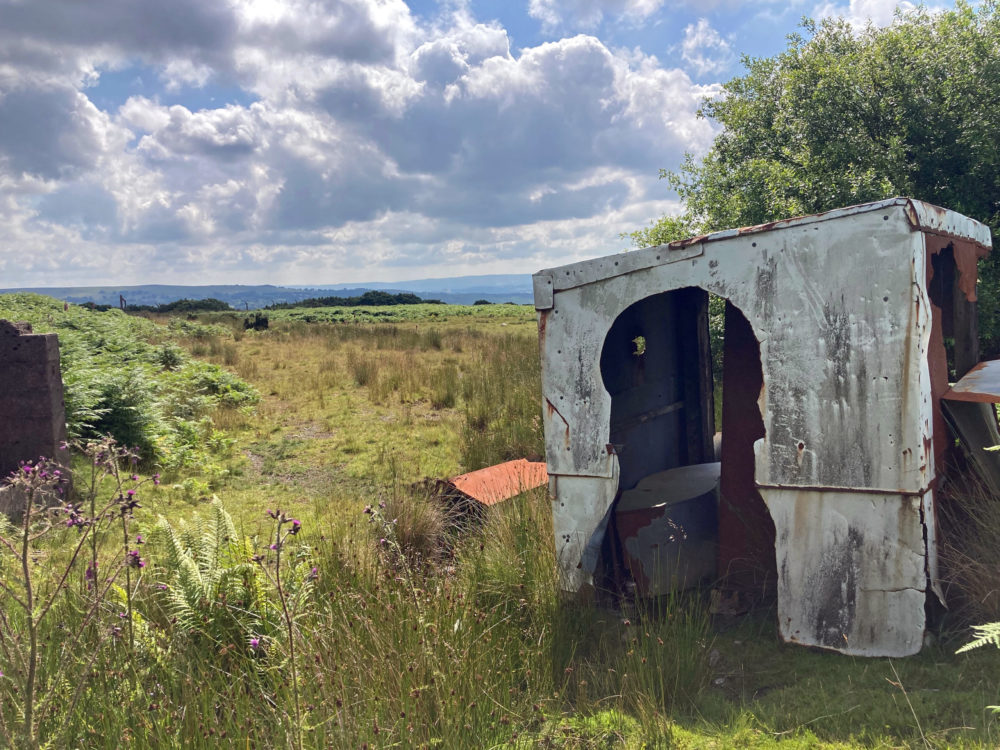Y Filltir Sgwâr/The Square Mile: The Last Colliery

In a year long series Tom Maloney, from Abersychan, shows how you can love a place so well it becomes a part of you.
The Last Colliery
Sometimes I just let the path lead the way when I am out and about in the landscape. There is a joy in not knowing quite where you are going and it is often surprising what you see when you turn the corner!
I think it was following a rocky mountain ridgeway high about the ruins of Graig Ddu Farm at Cwm Ffrwd that I happened on Graig Wen Colliery for the first time.
This is a place for grand views, but a line of redundant concrete posts, their tips encrusted with lichens, seemed so surreal to me then when set against a glorious backdrop of panoramic vistas that stretch as far as the Severn Estuary.

And … on my walk to the old mine this week it still felt surreal and took my thoughts to the paintings of Rene Magritte.
The official Magritte website leads with a quote where he describes his work.
‘Mystery’
“My painting is visible images which conceal nothing; they evoke mystery and, indeed, when one sees one of my pictures, one asks oneself this simple question, ‘What does that mean?’ It does not mean anything, because mystery means nothing, it is unknowable.”
It’s a great description of his artistic intentions and amongst the scattered relics that have become part of the story of this landscape a rusting, sheet metal cabin has just that sense of mystery.
Whether by accident or design the profile of a miner looks to have been carved into the structure of this time capsule, a mysterious reminder of the past perhaps, or perhaps nothing at all!

Nature has done much to conceal the entrance to the colliery, but the arched roadway into the hillside is still visible above the long grasses and flowering foxgloves.
In mining terms, this was a ‘drift mine’ where the coal deposits were extracted by digging into the side of a hillside above the water level.
The railway sleepers that line its structure, the handiwork of the last miners that worked here, protrude like an open mouth, almost as if it could talk.

I am often surprised that the history of a place like this is so ‘thin on the ground’.
The Northern Mine Research Society does shed some light on the timeline for Graig Wen. Permission to mine was granted under National Coal Board Licence in the 1970s and a succession of owners tried to work the coal, but in the end the colliery was abandoned.
Looking at the remaining artifacts on the surface I would think that Graig Wen might have been the last colliery to be worked in the area.

It is still possible to imagine how the mine may well have looked, quite probably a workplace that men and horses toiled together with each relying on the other in their different ways.
My grandfather worked as a haulier at Tirpentwys Colliery, which once employed hundreds of people nearby and I have often wondered about the bond that there surely must have been with the horses in their work deep underground.
As I sketched Graig Wen imagining it as a working drift mine I thought about how much things have changed in my lifetime. I must admit that I am not sad that people and horses no longer have to graft a living in this way.

(Photo: Tom Maloney)
It was hot and sunny on the morning of my walk and I had the company of so many Meadow Brown butterflies as I explored the site.
Though these lovely little brown butterflies are not rare or spectacular in their colour I do so enjoy their fluttering flight. They are quick and so nimble and have certainly made a home in numbers at Graig Wen.
And it was a double joy for me when I had the opportunity to photograph one at work as well!

That morning I think I would have gone home satisfied with just this one photograph of the Meadow Brown, but the wild flowers were not to be outdone.
I cannot remember ever seeing so many Foxgloves in one place before! It seemed like there were hundreds of these magical purple pink blossoms reaching for the sky. It was simply stunning.

But something troubled me as I took a closer look at the concrete block wall that had been built to seal the tunnel entrance.
A significant part of the wall had been taken down and while I admit it was fascinating to be able to view the tunnel I was very concerned that this may pose a considerable danger, especially over the schools summer holiday period.
I remembered seeing signage put up by the Coal Authority with a number that you can phone if you see something that causes you concern in former mining landscapes.
On contacting the authority the concern that I had was viewed very seriously and the action taken by this authority was immediate.
I enjoy roaming these old industrial sites and enjoy the difference that Nature has made, but it is also good to know that when there are problems there is a service dedicated to controlling hazards.
You can find out more about the work of The Coal Authority here.
Support our Nation today
For the price of a cup of coffee a month you can help us create an independent, not-for-profit, national news service for the people of Wales, by the people of Wales.




